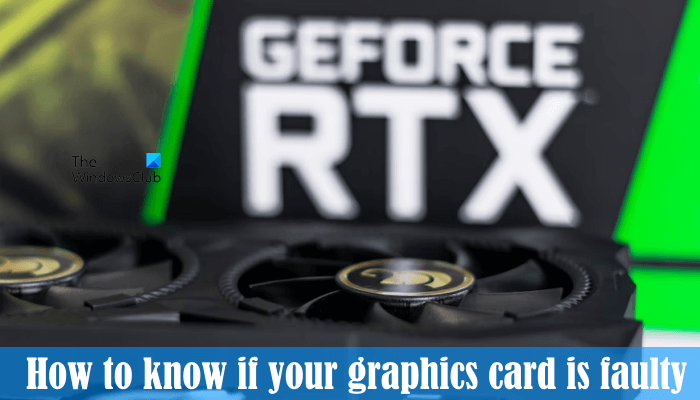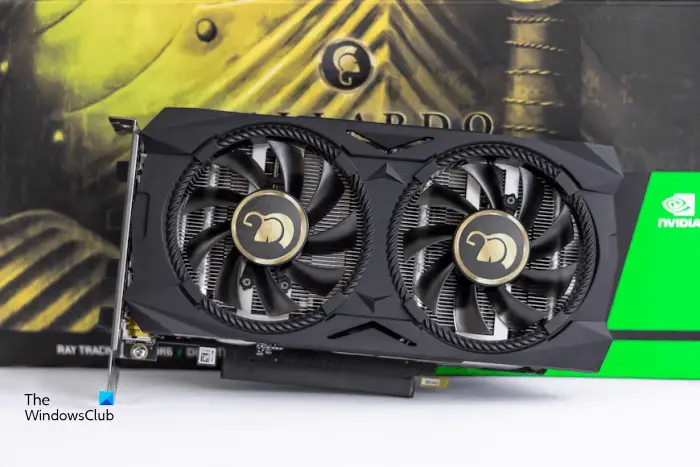A Graphics Card is essential hardware when it comes to gaming. Apart from gaming, a heavy-duty graphics card is also required for other purposes, like interior designing, Photoshop, video editing, etc. If your graphics card stops performing properly, you will experience issues with video games and other software which you use to perform graphics work. However, the same issues can be triggered due to other causes. Hence, before reaching any conclusion, it is necessary to check if the issue is occurring due to the GPU or not. In this article, we will talk about how to know if your graphics card is faulty.

You can perform a stress test on your graphics card to check if it is working properly or not. During a stress test, a graphics card is pushed to its absolute limits to check whether it is healthy or not. Furmark is a powerful GPU Stress Test Tool to test your Graphics Card. In addition to this, you can also perform a GPU benchmark test to test its performance. InfinityBench is a fast CPU & GPU Benchmark software for Windows 11/10.
How to know if your Graphics Card is working or not working?
If a graphics card is dying or not working properly, it shows some signs or symptoms. If you are aware of these signs or symptoms, you will easily predict that the health of your graphics card is not good. Hence, to know if your graphics card is faulty, you should know these signs or symptoms. If you notice the following signs or if your graphics card shows you the following symptoms, your graphics card may be faulty and it needs your attention.
- Frequent graphics glitches
- Stuttering or freezing effect
- Strange fan noise
- FPS drop
- Frequent game crashes or BSOD errors
Let’s discuss all these points in detail.
1] Frequent graphics glitches
Graphics glitches are one of the symptoms of a graphics card failure. However, there are other causes too that cause graphics glitches. The job of a graphics card is to render the graphics. If you notice graphics glitches frequently and in almost all games and programs, this is a sign that indicates your graphics card is facing trouble rendering graphics.
Graphics glitches include poorly-loaded textures, screen glitches, screen tearing, etc. There are two types of graphics cards, integrated and dedicated. The integrated graphics card is the built-in graphics card that is embedded in your system’s motherboard. On the other hand, the dedicated graphics card is the one that is connected to a system externally to handle heavy-graphics games and applications.
If your graphics card is going to be damaged, you will also experience graphics glitches outside of your games and software. For example, poorly-rendered text, icons, etc., on a Windows 11/10 computer.
2] Stuttering or freezing effect
If you see the stuttering effect while playing videos or video games, or your computer freezes every time you watch a video or play a game, the problem may be associated with your graphics card. However, you cannot jump to the conclusion only on the basis of stuttering or freezing effects because these problems may be caused due to a dying hard drive and RAM failure.
3] Strange fan noise

Graphics cards have fans that release the generated heat into the environment. Playing heavy graphics games generates more heat and when more heat is generated, the RPM of fans increases to protect the graphics card from damage due to heat. When fans run at a high speed for a long time, it is a matter of concern. It means that the heat generated while playing games or performing heavy graphics tasks is not released into the environment properly.
Strange fan noise is one of the symptoms of a dying graphics card but it doesn’t necessarily indicate that the problem is associated only with your graphics card. The accumulation of dust interferes with the heat sink due to which the excessive heat is not released into the environment. Due to this, fans have to work on a higher RPM for a long time. Strange fan noise can be an indication of excessive heat generation.
When you hear a strange fan noise, you should check your graphics card. Leaving your graphics card unchecked can damage your graphics card. Monitor your GPU temperature and clean it properly.
4] FPS drop
FPS drop in video games is one of the major problems for gamers. The drop in the frame rate depends on many factors. One of these factors is the dying graphics card. If the problem is associated with your graphics card, you will experience frequent FPS drops in almost all video games. You can keep an eye on your game FPS by installing the free FPS counter software.
5] Frequent game crashes or BSOD errors
As explained above, the purpose of a graphics card is to render the graphics. A faulty graphics card experiences problems while rendering the graphics. Due to this, you will experience many issues on your PC. Frequent game crashes are also caused due to a faulty graphics card. The game crashes also occur due to bad RAM. Hence, if most of your video games start crashing unexpectedly, run the Windows Memory Diagnostic Tool to check the health of your RAM. If your RAM is working fine, the next step is to check your graphics card.
Another symptom of a dying graphics card is BSOD errors. The Blue Screen of Death error is one of the notorious Windows 11/10 errors. There are many causes of BSOD errors. But if you see the BSOD errors every time when you start a graphic-intensive task, like playing a video game, watching movies, working on graphics software, etc., your graphics card may be going to die.
Windows Event Viewer is a powerful tool developed by Microsoft. You can use this tool to view the error logs on your system. Event Viewer also keeps a record of all BSOD errors. Open it and read the BSOD log files to know if your GPU is the culprit for the BSOD errors or not.
Related: Windows computer freezes while installing Graphics driver
How do I fix a faulty graphics card?
If your graphics card is generating excessive heat, check if it is clean or dirty. If you have not cleaned your graphics card for a long time, clean it. This will protect it from getting damaged. If it is already damaged, take it to the professional repair center to fix the faulty graphics card. Or if it is under warranty, contact the support center.
Read next: What are the signs of RAM failure and how to check faulty RAM?